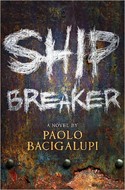 North, Pearl. The Boy from Ilysies. New York: Tor Teen, 2010. Print. Libyrinth 2.
North, Pearl. The Boy from Ilysies. New York: Tor Teen, 2010. Print. Libyrinth 2.[Book cover credit: librarything.com/work/10545774]
Both Libyrinth and The Boy from Ilysies could be read as stand-alone books, in my opinion. There is nothing mind-blowing in this second book that will ruin the first for you, but if you're planning on reading Libyrinth (and I suggest that you do), you should probably skip this review.
Booktalk:
Culturally, the Libyrinth is a utopia. Libyrarians and Singers, Ilysians and Ayorites all get along and work together. But they're still starving, and there are still growing pains. Po, the only Ilysian male, is feeling the latter acutely. He misses the green, fertile land of his youth, but more than that he misses living in a society where he knows what is expected of him.
Review:
I guess when I read Libyrinth I missed something key about Ilysies. I knew it was a matriarchal society, but I failed to notice that men are greatly outnumbered and treated as second class citizens. Things like that happen, I guess, when you're worrying about the torture of one protag and the budding romance between the other two. It is this second class status that has Po all mixed up in The Boy from Ilysies. Not only is he having problems thinking of Princess, I mean, Libyrarian Selene as just one of the girls and no more than anyone else, but he's also having trouble seeing himself as no less than. He's used to serving women like Selene, not working alongside them, and he's used to being emotionally taken care of, in return, by a matriarchal figure. All of this equality has left him feeling very alone and unsupported.
Much of the book is spent on this dilemma. It's interesting and important and turns gender stereotypes on their heads, but it wasn't what I was looking for in a sequel to the action-packed, literature-rich, POC and LGBTQ-featuring Libyrinth. I wanted more action than intrigue, more of Clauda's brashness and less of Po's confusion, more of the books' wisdom and less erections as feelings, more of the look-how-I've-grown Selene and less of the back-to-the-beginning Selene, more Nod(s), more Haly, and for the love, more Clauda AND Selene. When Po finally left on a quest, along with former Censor Siblea, Selene*, and a few others, I was so happy. I just wish that moment had come before I was halfway through the book.
But that second half of the book was totally worth it for me. The above group sets out for the former Singer headquarters to look for a tool from the legends of every major cultures' folklore that will hopefully make the land around the libyrinth fertile enough to support the community living there. Of course, when they get there, things do not go as planned, but in the course of the search and the fighting, we find out more about the foundations of the Singers' society. Their (former) reasoning behind the fear and demonization of the written word isn't exactly spelled out, but it makes a lot more sense now. Their still present culture of abuse and neglect of women also butts up against Po's sensibilities in a way that makes him take action rather than wallow in confusion and self-pity. The trip is also filled with danger, suspense, a cute but damaged girl for Po, and a cliff-hanger of an ending. I'm re-sucked in to this trilogy (or series?) an eagerly awaiting the as yet untitled Book 3.
Book source: Philly Free Library
*without Clauda! Have they really never gotten together? Were they together and have since broken up? Are they together but trying to keep things hush-hush? WHO KNOWS? We get to hear (a tiny bit) about Haly and her boyfriend from the first book. Why no follow-up on Clauda and Selene's relationship, North?
Links to Amazon.com may be affiliate links for the Amazon Associates program. If you buy something through this link, I may receive a referral fee.














